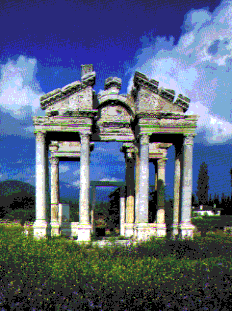Aphrodisias
Birth place
of the
goddess of love
History
One of the first remnants in the city is the 3,2 km. long city wall which
was constructed in 260 BC. You may see the Sebastian complex after you
leave the museum behind.
This gorgeous and matchless monument had
been
dedicated to the first Roman Emper or
Julius-Claudius's family, that is to
 Augustus,
Tiberius, Claudius and Nero. This monument
has an enterance
facing west and its
buildings stretch out to the east. Not far from
here
there is a 3-story building whose sides
can be easly viewed. The col umns
carrying
this structure had been covered with wall
panels with orijinal
reliefs. These
masterpieces covering a rich collection
created by
Aphrodisian sculptors are now
waiting the day they will be exhibited.
When we follow the pathway, the thea
tre
greets us. The neighboring arena circled by
columns is mentioned as Tetrastoon. This
open field had been used as a market place
in the old times.
Augustus,
Tiberius, Claudius and Nero. This monument
has an enterance
facing west and its
buildings stretch out to the east. Not far from
here
there is a 3-story building whose sides
can be easly viewed. The col umns
carrying
this structure had been covered with wall
panels with orijinal
reliefs. These
masterpieces covering a rich collection
created by
Aphrodisian sculptors are now
waiting the day they will be exhibited.
When we follow the pathway, the thea
tre
greets us. The neighboring arena circled by
columns is mentioned as Tetrastoon. This
open field had been used as a market place
in the old times.
Aphrodisias theatre is especially crucial
among Anatolian theatres. Its construction
date is back in the year 1 BC. Only the first
floor of the stage building, which used to
have 3 floors constructed with different
architectural styles, is standing
today. Their
restoration is still continuing. The theatre had
been constructed by Emperor Sear and
Augustus's freed slave Zoilos, and was
dedicated to Aphrodithe and to the local
people, as it is deduced from the inscription s
carved on the columns
of the first floor. The
name "archives wall " come from the
inscriptions on the stones to the right of the
stage. These are generally emperor letters
covering the privileges and honors granted
to the city and the agreements made by
neighboring citie
s.
The orchestra section in the form of a half
circle in the middle of the theatre had been
deepened and turned into an arena
(konistra) by emperor Marcus Aurelius.
When we continue to the west, down on the
right a gorgeous pool comes into view. The
p
ool surrounded by columns mentioned as
''Tiberius's ponico is 1,2 meters deep. It was
constructed in 2 AC in order to control a
spring that found its way to the face of the
earth due to a powerful earthquake. A great
number of contemporary researchers
and
archeologists share the view that the place
could have been a gymnasium.
The large area in the northern part of the
portico is the agora that is the heart of city's
economy..
It is a structure built mostly for musical
events. Eventually it was also serving the
purpose of holding public speech and
literature competitions.
Moreover, it was
functioning as the parliament building of the
city. Odeon was constructed in 2 AC and the
floor of the circular orchestra section was
covered with mosaics; The stage building
was decorated with magnificent sculptures.
Archelogists
found many unfinished statue
pieces and sculpturing tools during the
excavations done in the area between
Odeon and Aphrodithe temple. For this
reason the place is considered as the famous
sculpture school of Aphrodithe in archaic
ages.
Aphrodisian sculpture school is an important
atelier that was productive between the years
1 BC and 6 AC. Production of statues here
had continued till late archaic ages,
event hough the other schools in Anatolia
had ceased to exist in the same per
iod. Some
masterpieces have the signatures of their
creators who are especially experts in relief
and sarcophagus production. Many
sarcophagi were decorated with lively reliefs,
symbolizing the desire to deny the emptiness
of death and its eternal d
arkness. These
sculptors imposed their creative mastery over iron and marble. Iron tools and instruments
were to achieve victory and greatness not
only in battle fields but in the field of
sculpture as well. Anatolia was in a period
when matchless w
orks of sculpture were
created. The old traditions of Anatolian
sculpture reached a phase of lively fineness
and beauty of expression. Beauty aspirations
and love were to be stow stone and marble
with eternal power.
The structure next to sculpture
school with
its columns magnificiently climbing towards
the azure sky is where the city's heart is
beating; that is Aphrodithe Temple. The
temple constructed in lonian style has 13
columns in the longer side and 8 columns in
the shorter side. Aph
rodithe's cult, which is
now kept in the museum, had been standing
in the holy abode in the middle of the
temple whose construction was realized
between 41 BC and 130 AC. Inscriptions on
some of the columns inform us that the
temple was dedicated to
Aphrodithe and the
people. On the road streching from temples
to stadium, an interesting building
mentioned as philosophy school or the
house of philosophers was discovered
deduced from the inscriptions found during
the excavations.
We meet Aphrodisias's magnificient stadium
in the northern section of Philosophy school.
It is guessed that the stadium used to seat
30.000 people with its 262 m. Iength and 59
m. width. In Roman period Anatolian cities
had to get the permission from
Rome in
order to perform a play at the theatre.
Aphrodisias was one of those privileged
cities which got a consent. Festivals,
competitions, track and field events, box and
wrestling competitions were all being
arranged here.
While going back to Philosophy school from stadium we come across Tetrapylon. With its
high-rise pedestals, this monument was a
place where gratitude and demonstration
crowds used to gather and start to move.
Not far from Tetrapylon, you may encounter
a tomb made of Aphrodisias's white marble
under the shadow of a growing cypress tree..
This modest grave belongs to Prof.Dr. Kenan
Erim, a beloved personality who is
passionately fond of the city.
Whatever your belief, faith or religion is,
send hi
m a sincere hello from the heart and
say good-bye.
Aphrodisias museum is the richest local
museum owning the most original and
precious statue collection in Turkey. All the
masterpieces, came to light by the
excavations that have been led for 30 years
in this archaic city, are being preserved in
th
is museum. We encounter a series of
sculptures depicting mythological
events
covering gods, goddesses and emperors.
Aphrodithe greets us just at the enterance, in
the high-roofed section of the museum. On
its right one can see the statue of Antonius
Dometinus Diogenes who had been the
bishop of the temple in 2nd cc.. The
handsome man figure next to it, Demos,
represents the people of the city. The statue
of the goddess is vertically standing and
dressed. She wears a necklace in the form of
a ha
lf moon. On her garment there are
reliefs seperated by strips from each other.
The high relief head belongs to Zeus, the
14
greatest god of Olympus, the father of gods
and god of gods and to his wife Hera. Below
them the busts of sun god Helios and
moon
godess Selene follow. Holding the flambeaus
upside down by eros
symbolises death. The
reliefs on the Goddess are like a short
summary of life.
Existence, gods, time flowing like water,
death and infinity. Let's not forget to wish
luck to Prof.Dr. Bent Smith from New York
university who will lead the new excavations
in April after Prof.Dr. Kenan Erim.
 Source : Orhan Atvur, Photos:
Mehmet Biber, ATLAS Travel Magazine, August 1993.
Source : Orhan Atvur, Photos:
Mehmet Biber, ATLAS Travel Magazine, August 1993.
Back to home page
Send your comments to:
 Melih özbek
Melih özbek
melih@knidos.cc.metu.edu.tr
 Augustus,
Tiberius, Claudius and Nero. This monument
has an enterance
facing west and its
buildings stretch out to the east. Not far from
here
there is a 3-story building whose sides
can be easly viewed. The col umns
carrying
this structure had been covered with wall
panels with orijinal
reliefs. These
masterpieces covering a rich collection
created by
Aphrodisian sculptors are now
waiting the day they will be exhibited.
When we follow the pathway, the thea
tre
greets us. The neighboring arena circled by
columns is mentioned as Tetrastoon. This
open field had been used as a market place
in the old times.
Augustus,
Tiberius, Claudius and Nero. This monument
has an enterance
facing west and its
buildings stretch out to the east. Not far from
here
there is a 3-story building whose sides
can be easly viewed. The col umns
carrying
this structure had been covered with wall
panels with orijinal
reliefs. These
masterpieces covering a rich collection
created by
Aphrodisian sculptors are now
waiting the day they will be exhibited.
When we follow the pathway, the thea
tre
greets us. The neighboring arena circled by
columns is mentioned as Tetrastoon. This
open field had been used as a market place
in the old times.  Source : Orhan Atvur, Photos:
Mehmet Biber, ATLAS Travel Magazine, August 1993.
Source : Orhan Atvur, Photos:
Mehmet Biber, ATLAS Travel Magazine, August 1993.
 Melih özbek
Melih özbek